
On the evening of February 28, as thousands of spectators bustle into
BC Place Stadium in Vancouver for the closing ceremonies of the 2010
Winter Olympic Games, a celebration is going on in the large hall
beneath the stadium floor. The Canadian team has been gathering for
two hours prior to the ceremonies. With them, tonight, are people who
have worked tirelessly to support these athletes – including a number
of chiropractors.

|
|
On the evening of February 28, as thousands of spectators bustle into BC Place Stadium in Vancouver for the closing ceremonies of the 2010 Winter Olympic Games, a celebration is going on in the large hall beneath the stadium floor. The Canadian team has been gathering for two hours prior to the ceremonies. With them, tonight, are people who have worked tirelessly to support these athletes – including a number of chiropractors.
The games have been particularly special for several ‘firsts’ that have been witnessed on the international stage, as well as those that, while of import to the proceedings, have not been as widely publicized. One of these behind-the-scenes firsts is that, in addition to DCs working with various individual teams, chiropractic has also been included within the Host Medical Services for the Games, both Olympic and Paralympic. Now, DCs who have served in an official capacity share in the jubilant and relaxed mood that pervades the pre-ceremony party with the Canadian team. Although the stars are, obviously, the athletes, there is a realization that no one’s accomplishment is an isolated miracle, but the product of efforts on the part of all who have been involved.
Dr. Greg Uchacz, president of the College of Chiropractic Sports Sciences of Canada (CCSS(C)), notes that this event was one of the highlights of the Games for him as a team chiropractor, as CCSS(C) president and as a member of the chiropractic community.
“This was truly a high moment,” says Dr. Uchacz to Canadian Chiropractor magazine. “The work had been done, everyone knew what the results had turned out to be – there was no tension or wondering. It was an opportunity to relax, enjoy and actually experience what was going on.”
There is a history, spanning over 30 years of chiropractic service to Olympic athletes, behind this high moment. As Dr. Robert Armitage, Vancouver chiropractor and Supervisor of Chiropractic Services of the Host Medical Services for the Games, points out, “We stand on the shoulders of those who have come before us.” For chiropractic, the road to these Winter Games has been a long one that has involved the struggles, work, study and endurance of many DCs.
Canadian Chiropractor would like to take this opportunity to honour all those DCs who have had a role in establishing chiropractic services within the Olympic Games, a journey that has culminated in some definite triumphs at the 2010 Winter Olympic and Paralympics. They are too many to mention here, and so, we will focus on three Canadian figures who pioneered chiropractic’s involvement in Olympic Games and/or have been instrumental in this journey.
A look at the early days
Canadian Chiropractor caught up with Dr. Kenneth Mikkelsen, a DC who
has been involved with the Canadian swim team for over 25 years. Dr.
Mikkelsen was not involved with this year’s Winter Games but can be
considered one the forerunners of those DCs who served in an official
capacity there. Dr. Mikkelsen worked at his first Summer Olympics in
Seoul, Korea, in 1988, with the Canadian Olympic swim team before
current structures for accreditation had been established. He has been
to six Olympic Games ever since. He has also participated as Canadian
swim team chiropractor at about 70 international events, including as a
member of the core medical team of the 1998 Commonwealth Games in
Kuala Lumpur.
“Working with an actual sports organization was the way to go for
chiropractors,” says Dr. Mikkelsen. “In those days, it was a way for
chiropractors to gain accreditation for participating at the higher
levels of sport.”
“You worked with the athletes, one on one, for the full season and you
could to go with them to their games and competitive events because the
team requested to have you with them. Even today, this holds true. They
trust you and gain confidence in what you’re doing – they see that
chiropractic is actually enhancing the performance of each athlete.
They see results! Therefore, the athletes and the coaches begin
supporting you and ask that you be there with them at their events.
Eventually, you gain the support of national bodies in that sport as
well.”
Although the athletes Dr. Mikkelsen has worked with have been, by and
large, completely supportive of retaining chiropractic as a performance
enhancing and overall wellness service for the teams, he recalls some
of the obstacles and resistance that he has met up with along the way.
“In the early days, we did meet up with resistance – some of it quite
extreme – from some of the medical groups. Again, this called for
gaining trust and the confidence from members of other disciplines and,
to do this, it really helped that we were wanted by the athletes and
coaches. This confidence in us can only come from years of working with
each athlete, to the point of being the last person who lays hands on
him/her just before he/she steps out to compete.”
The trust and confidence that Dr. Mikkelsen continues to refer to as
cornerstones to the increasing involvement of chiropractic in elite
athletics begin with the knowledge base and extent of involvement
required to be a successful team chiropractor.
“You have to learn about the biomechanics involved in the sport you are
involved in. Then, you have to be thoroughly familiar with each
athlete’s patterns and tendencies in order to condition them for the
sport, while preventing overuse or repetitive strain injuries. You have
to become like the ‘mechanic in the pit’ – you learn to work fast and
be effective, without actually distracting the athlete from the task at
hand.”
Dr. Mikkelsen further notes that the skills and knowledge a
chiropractor gains by treating athletes, whose bodies and organization
are pristine, can be carried over and used to help patients in
practice.
Finally, Dr. Mikkelsen takes a moment to recognize other DCs who have been involved with Olympic athletes over the years.
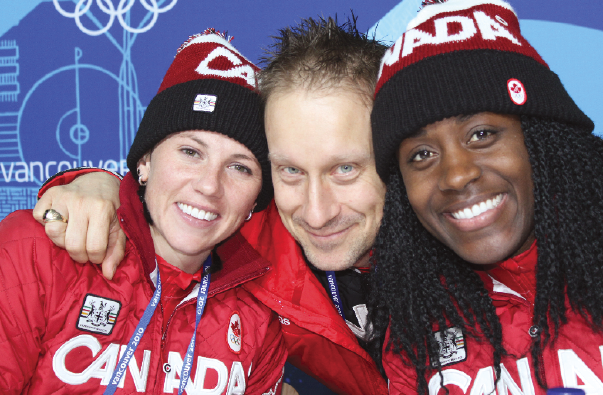
|
|
| Dr. Greg Uchacz, president, College of Chiropractic Sports Sciences of Canada, at a press conference with Silver Medallists Helen Upperton (Pilot – Women’s Bobsleigh (left)) and Shelly Ann Brown (Brakeman – Women’s Bobsleigh (right)). | |
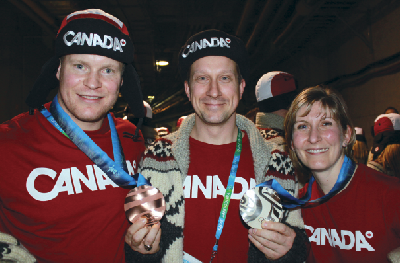 |
|
| Dr. Uchacz with Lyndon Rush (Pilot – Bobsleigh 4 Man Bronze Medallist) and Cori Bartel (Women’s Curling Silver Medallist). |
|
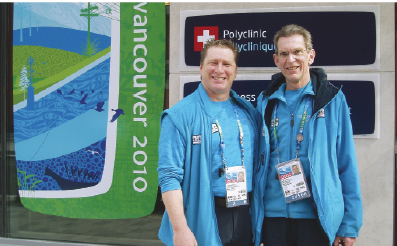 |
|
| Dr. Robert Armitage and Dr. Jack Taunton. | |
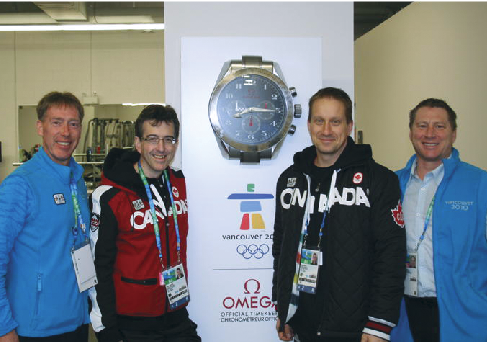 |
|
| Sports chiros left to right: Kevin Hooper, Brian Seaman, Greg Uchacz, Robert Armitage (Coordinator of Chiropractic, Host medical services, 2010 Vancouver Olympic and Paralympic Games). |
|
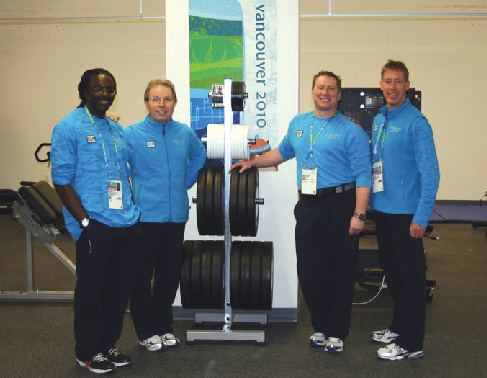 |
|
| Polyclinic sports chiros left to right: Wilbour Kelsick, Gordon Lawson, Robert Armitage (Coordinator), Kevin Hooper. | |
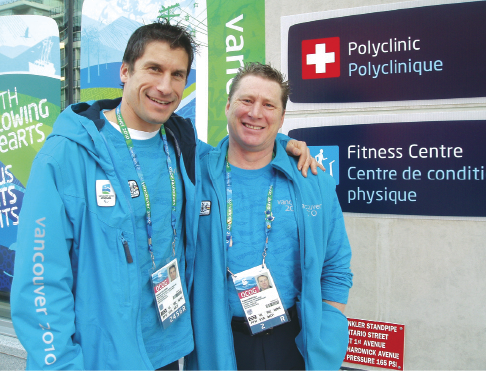 |
|
| Dr. Rick Celebrini And Dr. Robert Armitage.
|
“Dr. Taunton asked me, in 2005, to head chiropractic’s integration into the therapy services to be offered in the polyclinics at the 2010 Winter Olympic and Paralympic Games,” notes Dr. Armitage, whose life has been wrapped up in preparations for the past four years. “I had worked with him before, and we had enjoyed great integration of our respective expertise at previous athletic events. From this, came further associations. When I was regional supervisor of residents in the sports chiropractic fellowship program, Dr. Taunton – who had co-founded the Allan McGavin Sports Medicine Clinic at UBC – included us amongst the attendees at clinical and radiological rounds along with sports-med MDs, physiotherapists, doctors and residents from other specialties. He became a staunch supporter of chiropractic and still supports the profession and its colleges.”
Dr. Armitage notes that the effort to include chiropractic in the Host Medical Services did not begin with the preparations for the 2010 Winter Games, but that these were the Games through which this effort came to fruition.
“For more than 30 years, there have been chiropractors serving at the Olympics on an individual and national team basis and chiropractic utilization amongst athletes, internationally, has grown as a result of this participation. These Games have been a pinnacle moment for sports chiropractic – and for chiropractic in general, as it increases its profile to the general public – because we were also able to achieve inclusion into the Host Medical Services offered by Canada for the Games. We treated the athletes, their families and accredited team and IOC members, and volunteers at the Games.”
How it all worked
“As Chief Medical Officer, Dr. Taunton was responsible for selecting and organizing all of the members of his medical teams” continues Dr. Armitage. “He selected chiropractic – and me, myself, to head it – and then it was my job to organize selection of the members of the chiropractic team using the process outlined by the selection policy of the CCSS(C) for Major and Minor games. It was up to us to put together recommendations for who should be included, but the final selection was up to the Vancouver Organizing Committee for the 2010 Olympic and Paralympic Games (VANOC) and the International Olympic Committee (IOC). In the end, for every shift the polyclinics were open, during both the Olympic and Paralympic arms of the Games, there was a chiropractor present and on staff in the polyclinic.”
There were two polyclinic facilities available to provide Host Medical Services at the Games – one in Vancouver and one in Whistler. Both clinics, notes Dr. Armitage, were staffed by personnel from 37 health care subspecialties that were grouped into various therapeutic and diagnostic categories. CT, MRI and diagnostic U/S were available on-site in both clinics. The polyclinic at Whistler also housed surgical facilities for those situations where immediate transport of an individual was not possible.
Within this setup, chiropractic fell under the category of therapy. It was Dr. Jack Taunton’s wish that therapy services – adeptly coordinated, according to Dr. Armitage, by Chief Therapist, Rick Celebrini, a sports physiotherapist and PhD candidate – included practitioners from a variety of areas such as acupuncture, massage, physiotherapy, and so forth, as well as chiropractic. For specialists of all disciplines to be accredited by VANOC and IOC to treat athletes, they were required to be members of specialty colleges in their fields. This meant chiropractors chosen for the job were all Fellows of the Chiropractic College of Sports Sciences of Canada. There were 327 chiropractic volunteer applicants – including general practitioners for what originally was to include care for media, spectators and workforce members – for what turned out to be 22 coveted positions within the polyclinics.
Execution of successful medical service provision, within the polyclinics, depended on a philosophy that was dubbed “one examining table, surrounded with multidisciplinary teams, each participating and demonstrating their skill sets.”
“This worked astoundingly well for utilization and integration of chiropractic services,” says Dr. Armitage, “and resulted in many compliments back to us from individuals, as well as the national sports organizations and the IOC.”
Fostering relationships and professional development
Dr. Greg Uchacz sees the 2010 Winter Olympic and Paralympic Games as having been an opportunity for the international community to watch chiropractic through a microscope as it works at its highest level. He, too, has been part of the profession’s journey into elite athletics and, ultimately, the Olympics for a number of years. Through his work with the CCSS(C), Dr. Uchacz has overseen the creation and implementation of a post-graduate sports chiropractic fellowship program; a program that caught the attention of the IOC when it came to the decision making process for chiropractic’s inaugural inclusion. This, he notes, has increased awareness and status of sports chiropractic as a leader in education and clinical skills amongst athletic care specialties.
“We’ve increased our market share,” says Dr. Uchacz, the Alberta DC who is finally enjoying some time with his family after a hectic, but rewarding time, in Vancouver. “We now sit at the table and that gives us the opportunity to help in the decision making process when it comes to health care support for Canada’s top athletes. The other sports health professions realize that our mandate is athlete centred with a firm commitment to collaborating in a truly integrated system.”
“Having personal interaction with other health professionals was one of the high points of working at the games,” continues Dr. Uchacz, who served as team chiropractor for Canadian Bobsleigh and Skeleton teams. “Things happen in real time – a team physician and I discussed the need to have one particular athlete undergo an MRI. We basically escorted the individual to the athlete village polyclinic, where the evaluation was completed within a 15-minute period. Afterward, the radiologist consulted with us on the specific findings. The entire process took less than one hour. Not only was the process efficient and unparalleled in its execution – it was inclusive and integrated with all health professionals involved.
As a Canadian team chiropractor, some of Dr. Uchacz’s experiences parallel those of Dr. Kenneth Mikkelsen. He worked with various teams for a long enough period to develop a solid relationship and establish the appreciation and trust of the athletes and their administration. From there, working at high level competitions in an official capacity becomes commonplace for an organization that fundamentally supports promotes the chiropractor’s involvement. But, as president of the CCSS(C), Dr. Uchacz’s work has gone beyond the individual team dynamic, taking chiropractic deeper into athletic circles, thus lifting sports chiropractic higher on the scale of acceptance and inclusion into the sports medicine mainstream.
“We (the CCSS(C)) have several projects going on that continue to firmly entrench sports chiropractic within the mainstream sports medicine model in Canada and internationally,” says Dr. Uchacz. “In one instance, we’ve seen the Canadian Sport Centres include sports chiropractic within their funding structure.
Athletes can access chiropractic sports fellows for services – these fellows can then, in turn, bill the sport centres for services rendered. Also, we worked closely with the other health care professions in the development of a national standardized billing rate card, thus, standardizing fee-for-service across the country, whether it be for specific appointments or for salaried positions. Our inclusion in the rate card development process helped us become equal players with the other sports health care professions, thereby enhancing opportunities for access to all sports chiropractors.
“Also, the sports fellowship program in chiropractic, with a master’s level educational format, 1000 hours of practical application requirements, and research publication among other requirements, has really boosted our ranks and garnered respect amongst the other specialties,” continues Dr. Uchacz. “The movement for a more extensive specialty status for sports chiropractors has sent the message to the other specialties that DCs are fully qualified and are placing the best interests of the athletes in the forefront. It has certainly brought sports chiropractic more into the mainstream of sports medicine, including our integration into sports at the highest level: the Olympic and Paralympic Games.
Chiropractic and accredited media
The 2010 Winter Olympic and Paralympic Games were broadcasted into the living rooms of millions through various accredited media groups. In Canada, Canada’s Olympic Broadcast Media Consortium was the official broadcaster of the Games. The Consortium, a partnership between CTV Inc. and Rogers Media Inc., provided complete coverage in a total of 22 languages, on multiple platforms, including two official websites.
It was through this internet platform that the Canadian Chiropractic Association (CCA) found an opportunity for another Olympic first – to present tips and information for health and wellness from a chiropractic perspective. The CCA recognized the receptive atmosphere which had been created for chiropractic through its inclusion in the Host Medical Services, as well as with the various athletic teams. Furthermore, it was evident that millions would be viewing coverage of the games on CTV and visiting its websites for further details. Therefore, through sponsorship and designing a web-page dedicated to health and wellness stemming from chiropractic knowledge, the CCA achieved a platform for the profession to reach out to the world through the CTV coverage site. The page, titled “Chiropractic Corner”, highlighted a number of sports safety issues as well as the Fit-in-15 program designed by the CCA, and was visited by a wide international audience throughout the Olympic and Paralympic Games.
Beyond 2010
It is difficult for any of our three chiropractors to comment on exactly what happens with chiropractic, on the Olympic stage, from here. Not one of them feels there is reason to believe that the momentum gained by chiropractic leading up to, and throughout, the 2010 Winter Olympic and Paralympic Games will be lost or diminished, in any way, although all three note that the nature of involvement in future games has yet to be defined.
All three agree that involvement of chiropractors with the teams from various nations along with the newest development – i.e., integration of chiropractors into the Host Medical Services for the Games – has a positive impact on the importance of chiropractic in sports medicine, both from the point of view of the athletes and their coaches and organizations, and from the point of view of practitioners of other health care disciplines. Furthermore, all three agree that this intimate involvement of DCs in elite athletics will transmit to become positive exposure for chiropractic with respect to the general public, thus heightening the potential for increased utilization of DCs within health systems. Finally, all three agree that the Olympic experience is one that strengthens a practitioner’s knowledge and skill sets, as well as the ability to practice effectively within an interdisciplinary environment.
What remains to be seen is how the currently palpable momentum that has carried the profession to new heights on its journey to the Olympic and Paralympic Games will be harnessed for its future integration into these important events . This, therefore, is not the end of this story – the real story, in fact, has just begun.
(Canadian Chiropractor magazine would like to thank Drs. Mikkelsen, Uchacz and Armitage for their contributions to this article, and to Dr. Armitage for submitting it for review and authorization by VANOC and IOC personnel. At the time this article was prepared, the Paralympic Games, in which chiropractors also participated, were underway and, thus, we could not include comments on these Games.)
Print this page